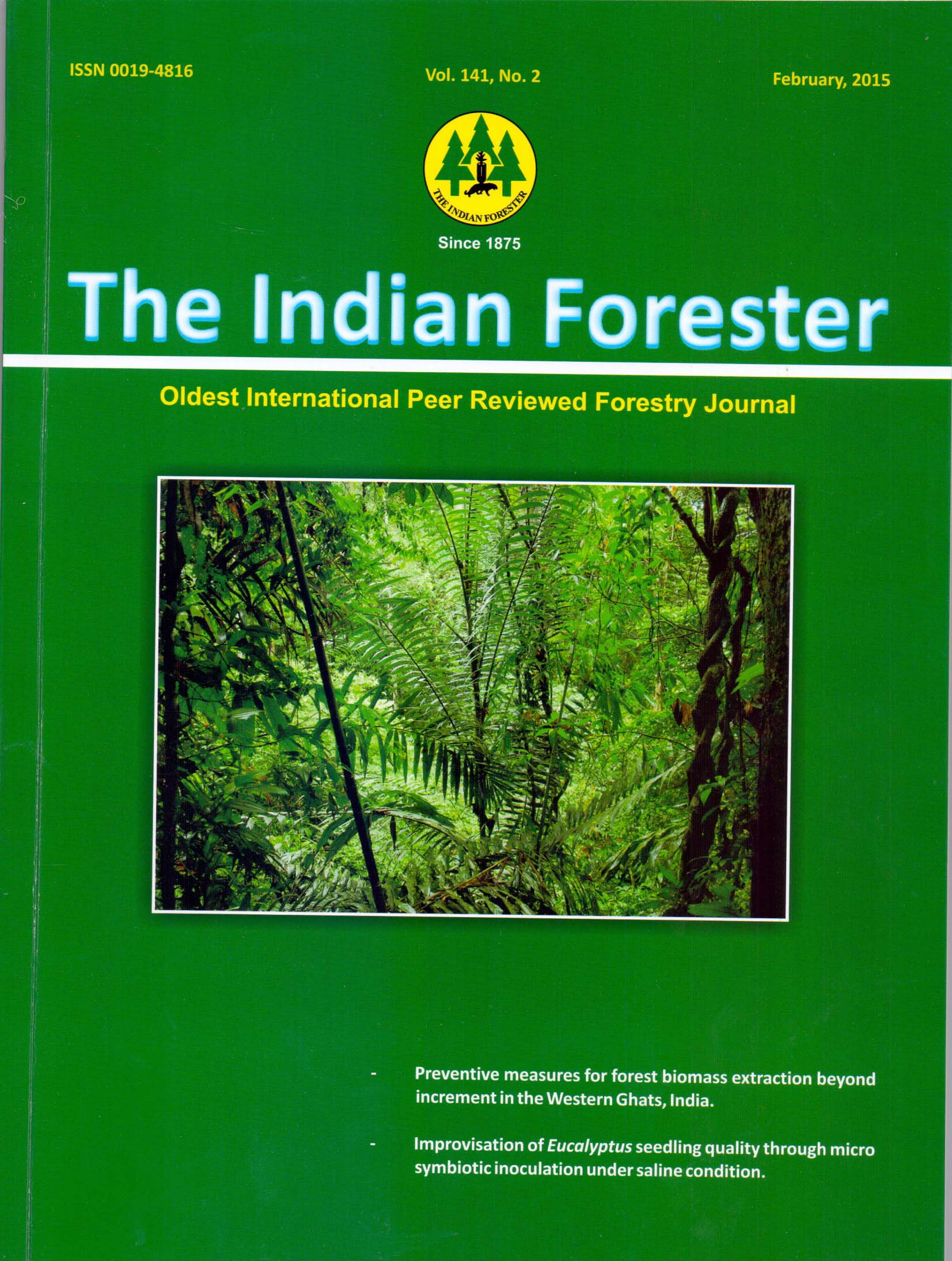Preventive Measures for Forest Biomass Extraction Beyond Increment in the Western Ghats, India
DOI:
https://doi.org/10.36808/if/2015/v141i2/60644Keywords:
Biomass Extraction, Biomass Conservation, Mean Annual Increment, Uttara Kannada, Western Ghats.Abstract
The study was carried out in four selected villages of Uttara Kannada district in the Western Ghats with an aim to present the annual change in biomass using estimated stock and extraction, and to estimate the reduced extraction due to conservation practices. The data collected from a vegetation survey of eight one hectare sites in the forests, and a biomass extraction survey involving 247 households were subjected to a sensitivity analysis of community's pressure on the forests using the estimates of mean annual increment (MAI) in biomass quoted by various studies. The results show that at an MAI rate of 2.1 t/ha, on an average, the annual extraction by the community is 62% of the increment in biomass, however the values range from 143% to 39% between the villages. A shift to fuel efficient stoves and live fences by a little more than a quarter of the surveyed households shows a reduction in annual biomass extraction to 56% of its MAI, and a potential reduction to 17% in case all the households adopt conservation practices.References
Bhat D.M. and Gadgil M. (1987). Aboveground herblayer productivity under different land use systems in Uttara Kannada district of Karnataka, Technical report number 20, Centre for Ecological Sciences, Indian Institute of Science, Bangalore, India.
Bhat D.M., Murali K.S. and Ravindranath N.H. (2003). Carbon stock dynamics in tropical rain forests of Uttara Kannada district, Western Ghats, India, International Journal of Environment and Pollution, 19(2): 139-149.
Bhat D.M. and Ravindranath N.H. (2011). Above-ground standing biomass and carbon stock dynamics under a varied degree of anthropogenic pressure in tropical rain forests of Uttara Kannada district, Western Ghats, India, Taiwania, 56(2): 85-96.
Buchy M. (1996). Teak and Arecanut: Colonial State, Forest, and People in the Western Ghats (South India), 1800-1947. French Institute and Indira Gandhi National Centre for the Arts, Pondichery and New Delhi.
Condit R. (2008). Methods for estimating aboveground biomass of forest and replacement vegetation in the tropics, Center for Tropical Forest Science Research Manual, pp.73.
Falvey L. (1982). Gliricidia maculata: a review, International Tree Crops Journal, 2(1): 1-14.
Gadgil M. (1987). On diversification of common property resource use by the Indian society, Technical report number 38, Centre for Ecological Sciences, Indian Institute of Science, Bangalore.
Government of Karnataka (2010). Annual Report for the year 2009-2010, Karnataka Forest Department, Bangalore, India.
Hegde M.S. (1986). Propagation of hosa ole: ASTRA ole at Unchagi, Hosa Heravatta and Kotegudde villages of Uttara Kannada, Technical report number 15, Centre for Ecological Sciences, Indian Institute of Science, Bangalore.
Karanth K.K., Curran L.M. and Reuning-Scherer J.D. (2006). Village size and forest disturbance in Bhadra Wildlife Sanctuary, Western Ghats, India, Biological Conservation, 128(2): 147-157.
Lele S.M. (1993). Degradation, sustainability or transformation? A case study of villagers' use of forest lands in the malnad region of Uttara Kannada district, India, Technical Report Number 27, Centre for Ecological Sciences, Indian Institute of Science, Bangalore, India.
Mani A. (1985). Agrarian technology and ecodegradation of betta forests in Salkani village in North Kanara district, Karnataka, Technical report number 1, Centre for Ecological Sciences, Indian Institute of Science, Bangalore, India.
Mehta V.K., Sullivan, P.J., Walter, M.T., Krishnaswamy, J. and DeGloria, S.D. (2008). Impacts of disturbance on soil properties in a dry tropic forest in southern India, Ecohydrology, 1(2): 161-175.
Murali K.S., Murty I.K., Nagaraj B.C. and Ravindranath N.H. (2004). A decade of JFM and its ecological impacts. In: Root to canopy-regenerating forests through community-state partnerships (V.K. Bahuguna, D. Capistrano, K. Mitra and S. Saigal, Eds.), Winrock International India and Commonwealth Forestry Association, New Delhi, India, pp. 1 22.
Nadkarni M.V., Pasha S.A. and Prabhakar L.S. (1989). Political Economy of Forest Use and Management. Sage Publications, New Delhi.
Ninan K.N. (2007). The Economics of Biodiversity Conservation: Valuation in Tropical Forest Ecosystems. Earthscan Publications, London.
Parthasarathy N. (1999). Tree diversity and distribution in undisturbed and human-impacted sites of tropical wet evergreen forest in southern Western Ghats, India, Biodiversity Conservation, 8(10): 1365-1381.
Prasad S.N., Hegde H.G., Bhat D.M. and Hegde M. (1987). Estimates of standing biomass and productivity of tropical moist forests of Uttara Kannada district, Karnataka, India, Technical report number 19, Centre for Ecological Sciences, Indian Institute of Science, Bangalore, India.
Rai S.N. (1984). Above ground biomass in tropical forests of Western Ghats, India, Indian Forester, 110(8): 754-764.
Ramachandra T.V., Subramanian D.K., Joshi N.V., Gunaga S.V. and Harikantra R.B. (2000). End use efficiencies in the domestic sector of Uttara Kannada district. Energy Conversion and Management, 41(8): 833-845.
Ravindranath N.H., Murali K.S. and Sudha P. (2006). Community forestry initiatives in southeast Asia: a review of ecological impacts, International Journal of Environment and Sustainable Development, 5(1): 1-11.
Ravindranath S. and Premnath S. (1997). Biomass studies-field methods for monitoring biomass. Oxford and IBH publishing Co Pvt Ltd, New Delhi and Calcutta, India.
Reddy A.N.Y., Sarmah D., Pande P., Narvekar G.B., Gouda B.S. and Yekanthappa K. (1986). Integrated approach for eco development of Uttara Kannada district, Conservator of Forests, Kanara Circle.
Shrinidhi A.S. and Lele S. (2001). Forest tenure regimes in the Karnataka Western Ghats: a compendium, Working paper number 90, Institute for Social and Economic Change, Bangalore, India.
Simons A.J. and Stewart J.L. (1994). Gliricidia sepium: a multipurpose forage tree legume. In: Forage tree legumes in tropical agriculture (R.C. Gutteridge and H.M. Shelton, Eds.), CABI, Wallingford, UK, pp. 30-48.
Whitmore T.C. (1984). Tropical Rain Forests of the Far East.Second edition, Clarendon Press, Oxford, UK.
Downloads
Downloads
Published
How to Cite
Issue
Section
License
Unless otherwise stated, copyright or similar rights in all materials presented on the site, including graphical images, are owned by Indian Forester.





